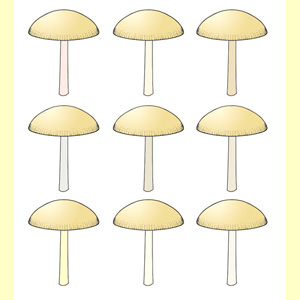
If the colour can best be described as a modification of one colour by another, you should usually choose the main colour. So, if the colour is reddish orange, choose orange, and if yellowish brown, choose brown. However, where there are tints of blue, green or purple, these states should be chosen.
Colour charts are referred to in capitals: BFF (Royal Botanic Gardens Edinburgh, 1969), METHUEN (Kornerup & Wanscher, 1978) and RAYNER (Rayner, 1970).
The same colour name can be applied to different colours in different colour charts (compare apricot in BFF and METHUEN). If a colour is on the border between two of the categories (such as the orange yellow colour apricot, or the blue green colour verdigris) choose both colours.
This category is used for colours that have a yellow, brown, red, pink or orange tint but are very pale. If there is any green, blue or purple tint, choose those options.
Using the METHUEN colour chart, all colours that match closest to the A2 colour chips on pages 1 to 13 belong here, and also colours that are paler than this but not white.
